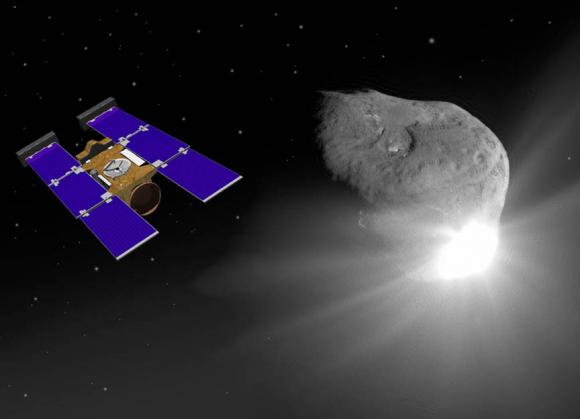Although comets have been hurtling through the solar system since its earliest history 4.6 billion years ago, we know little about these ancient celestial wanderers.
Scientists expect to learn a little more when a NASA spacecraft called Stardust flies to within 124 miles of the comet Tempel 1 on Valentine’s Day. The encounter with the dark, spud-shaped behemoth — with a mass between 70 and 110 billion tons — will mark the first time that scientists can look for changes on a comet’s surface caused by a close flyby of the sun. It also will be the first time that a comet has been revisited; in 2005, another NASA spacecraft recorded the collision of a projectile with Tempel 1.
NASA is holding a news conference on Jan. 19, 2011, to discuss the upcoming Tempel 1 encounter. Peter Schultz, professor of geological sciences and a co-investigator on the mission, called Stardust-NExT, will be one of four panelists at the briefing. The briefing will be broadcast live beginning at 1 p.m. on NASA TV and streamed live on the agency’s website.
“Tempel 1 has finished one tour of the solar system, from its closest approach to the sun just inside the orbit of Mars and then out to the orbit of Jupiter,” Schultz said. “So, this is just over one full year for this comet.”
During its flyby, the Stardust spacecraft is expected to obtain high-resolution images of Tempel 1’s nucleus, or coma, an area that is usually heavily obscured by dust and gas. The spacecraft also will study, through various measurements, how a comet changes after it has completed two close flybys of the sun.
Schultz, an expert in cometary impacts, is especially interested in seeing how the crater formed by the 2005 impact of Tempel 1 has changed the comet’s nucleus.
“For the first time, we will have a look at how this comet has changed,” Schultz said. “Have features disappeared? Have new deposits formed?”
Comet clues
Due to their age, comets are believed to house debris dating back to the early history of the solar system, yet they remain among the most enigmatic bodies in our galactic neighborhood. Because they are composed of significant fractions of water ice, dust, and carbon-based compounds, some scientists think comets may have contributed some of the volatiles that make up our oceans and atmosphere. Some also think comets brought to Earth the complex molecules from which life arose.
Little evidence has been gathered to support all the theories. Only in the last decade has NASA made a concerted effort to study comets. The first mission to study a comet, involving Stardust, was launched in 1999. There have been just five instances in which a spacecraft from Earth has imaged a comet close up.
In November, Schultz and graduate student Brendan Hermalyn discussed results from another NASA spacecraft’s fly-by of the Hartley 2 comet. That encounter was from 435 miles away, meaning that the Tempel 1 flyby will be more than two-thirds closer.
“We should see parts of the nucleus we haven’t seen and document the processes that shape the comet’s surface,” Schultz noted. “If we are lucky, we will also be able to see what happened to the crater. This is like sticking our thumb in the sand on Earth and checking what happens after one year.”

